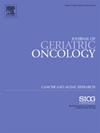虚弱对卵巢癌护理的普遍影响和康复的作用:关键利益相关者的定性观点。
IF 3
3区 医学
Q3 GERIATRICS & GERONTOLOGY
引用次数: 0
摘要
简介:我们进行了一项定性研究,以探讨关键利益相关者对虚弱对卵巢癌护理影响的观点,并评估一种候选的康复干预措施。材料和方法:我们对患者-护理人员和多学科临床医生进行了半结构化访谈。患者年龄≥50岁,新诊断为晚期(III/IV)卵巢癌,在过去一年中接受了针对癌症的治疗(化疗和/或手术),并且使用虚弱量表符合虚弱或虚弱的标准。我们使用半结构化访谈指南来询问参与者对虚弱、营养、物理治疗和候选康复干预的看法。我们使用归纳和演绎的方法来编码和分析访谈,并确定紧急主题和模式。结果:对10名患者及护理人员(5对)和10名医护人员进行了访谈。我们确定了四个主题:(1)虚弱筛查对于预防过度治疗和治疗不足至关重要,但未得到充分利用;(2)利益相关者更倾向于多学科方法为虚弱患者提供量身定制的护理,而不是候选的康复干预;(3)患者、家庭照顾者和临床医生利益相关者报告了康复计划的多重障碍,包括对选择偏见的担忧;(4)虚弱的患者和家庭成员很脆弱,需要更多的社会心理支持。讨论:我们确定了对虚弱的卵巢癌患者进行康复干预的重大障碍;加强虚弱筛查和提供量身定制的多学科方法的举措可能会产生更大的影响。本文章由计算机程序翻译,如有差异,请以英文原文为准。
The pervasive impact of frailty on ovarian cancer care and the role of prehabilitation: Qualitative perspectives of key stakeholders
Introduction
We performed a qualitative study to explore key stakeholders' perspectives about the impact of frailty on ovarian cancer care and evaluate a candidate prehabilitation intervention.
Materials and Methods
We conducted semi-structured interviews with patient-caregiver dyads and multi-disciplinary clinicians. Patients were ≥ 50 years of age with a new diagnosis of advanced stage (III/IV) ovarian cancer who received cancer-directed treatment (chemotherapy and/or surgery) during the past year and met criteria as pre-frail or frail using the FRAIL scale. We used a semi-structured interview guide to elicit participants' views on frailty, nutrition, physical therapy, and a candidate prehabilitation intervention. We used inductive and deductive approaches to code and analyze interviews and identify emergent themes and patterns.
Results
Ten patients and caregivers (five dyads) and 10 providers were interviewed. We identified four themes: (1) frailty screening is essential to prevent over- and under-treatment, but underused; (2) stakeholders preferred a multidisciplinary approach to providing tailored care for frail patients over a candidate prehabilitation intervention; (3) patient, family caregiver, and clinician stakeholders reported multiple barriers to prehabilitation programs, including concerns about selection bias, and (4) frail patients and family members are vulnerable and require more psychosocial support.
Discussion
We identified significant barriers to prehabilitation interventions for frail patients with ovarian cancer; initiatives to increase frailty screening and provide tailored multi-disciplinary approaches may have a greater impact.
求助全文
通过发布文献求助,成功后即可免费获取论文全文。
去求助
来源期刊

Journal of geriatric oncology
ONCOLOGY-GERIATRICS & GERONTOLOGY
CiteScore
5.30
自引率
10.00%
发文量
379
审稿时长
80 days
期刊介绍:
The Journal of Geriatric Oncology is an international, multidisciplinary journal which is focused on advancing research in the treatment and survivorship issues of older adults with cancer, as well as literature relevant to education and policy development in geriatric oncology.
The journal welcomes the submission of manuscripts in the following categories:
• Original research articles
• Review articles
• Clinical trials
• Education and training articles
• Short communications
• Perspectives
• Meeting reports
• Letters to the Editor.
 求助内容:
求助内容: 应助结果提醒方式:
应助结果提醒方式:


